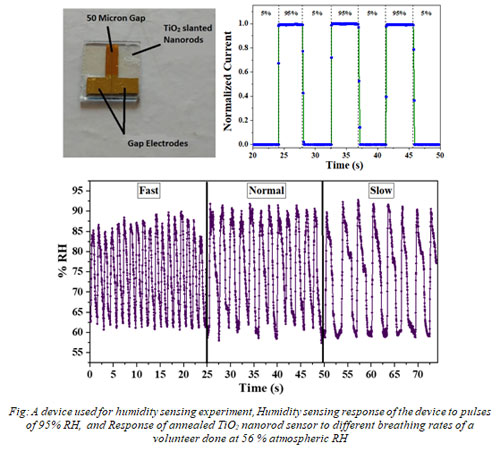 Scientists at the Centre for Nano and Soft Matter Sciences (CeNS) Bangalore an autonomous institute of the Department of Science & Technology, Government of India have developed a metal oxide semiconductor (MOS) based humidity sensor, which can easily detect humidity in the laboratory as well as dehydration in patients through breath analysis.
Scientists at the Centre for Nano and Soft Matter Sciences (CeNS) Bangalore an autonomous institute of the Department of Science & Technology, Government of India have developed a metal oxide semiconductor (MOS) based humidity sensor, which can easily detect humidity in the laboratory as well as dehydration in patients through breath analysis.The device made of titanium dioxide nanorods can be easily fabricated with the help of physical vapour deposition technique (PVD), a process used to produce a metal vapour that can be deposited on electrically conductive materials as a thin, highly adhered pure metal or alloy coating.
Dr. S Angappane and his team from CeNS developed the TiO2 nanorods with the help of PVD techniques such as sputtering and electron beam evaporation involving glancing angle deposition. The research was published in the journal Sensors and Actuators A: Physical.
The sensor consists of 50-micron gap electrodes on the quartz substrate above which slanted nanorods array structures are grown, by applying a voltage (0.5 - 1.5 V) between gap electrodes, this device works as a humidity sensor with fast response and recovery. Finally, to check the practical applicability, the TiO2 nanorod sensors were used to analyze the humidity level in exhaled human breath to determine the dehydration level. With suitable electronics and a device area greater than 0.04cm2, a compact portable and affordable humidity sensor/breath analyzer, can be fabricated with high sensitivity.
Atmospheric relative humidity levels play an essential role in conducting experiments in a laboratory as well as chemical/material industries. Detection of relative humidity % within a fraction of seconds will always be preferred in such situations. A device with a swift response and recovery is useful to determine whether a patient is showing signs and symptoms of dehydration.
The team is further working on interfacing the device with electronic gadgets.
Publication details: Humidity sensing and breath analyzing applications of TiO2 slanted nanorod arrays; Hiran Jyothilal, Gaurav Shukla, Sunil Walia, Suman Kundu, S. Angappane; Sens. Actuators A Phys. 301 (2020): 111758. (DOI: https://doi.org/10.1016/j.sna.2019.111758)
For further details, Dr S. Angappane (Email: angappane[at]cens[dot]res[dot]in) can be contacted.






























